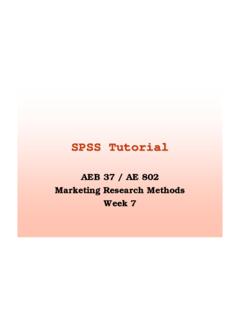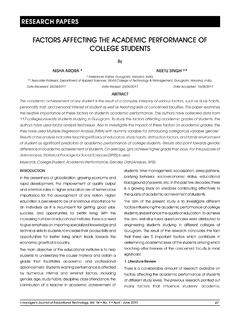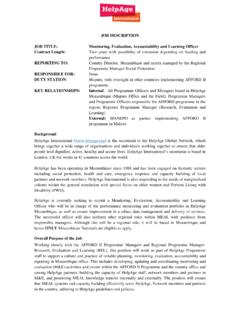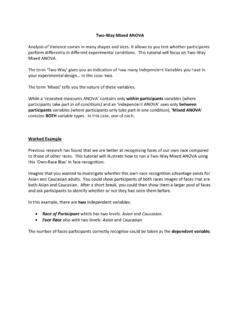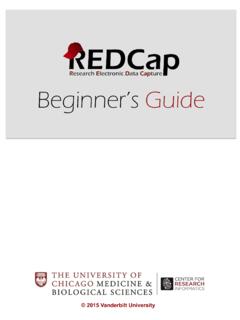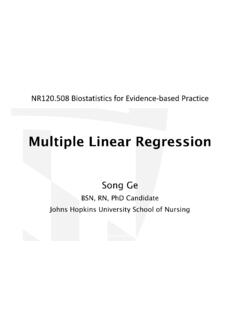Transcription of Comparing One or Two Means Using the t-Test
1 3 Comparing One or TwoMeans Using the t-TestThe bread and butter of statistical data analysis is the Student s was named after a statistician who called himself Student but whosereal name was William Gossett. As an employee of Guinness Brewery inDublin, Ireland, he tackled a number of practical statistical problems relatedto the operation of the brewery. Since he was discouraged from publishingunder his own name, he adopted the Student of Gossett s work, today s researchers have in their toolbox whatis probably the most commonly performed statistical procedure, the most typical use of this test is to compare Means , which is the focus ofthe discussion in this chapter. Unfortunately, because this test is easy to use,it is also easily this chapter, you will learn when, why, and how to appropriately per-form a t-Test and how to present your results. There are three types of t-teststhat will be discussed in this chapter.
2 These are the1. One-sample t-Test , which is used to compare a single mean to a fixed numberor gold standard 2. Two-sample t-Test , which is used to compare two population Means based onindependent samples from the two populations or groups3. Paired t-Test , which is used to compare two Means based on samples that arepaired in some 7/18/2006 3:43 PM Page 47 These three types of t-tests are discussed along with advice concerningthe conditions under which each of these types is appropriate. Examples aregiven that illustrate how to perform these three types of t-tests Using spss software. The first type of t-Test considered is the t-TestThe one-sample t-Test is used for Comparing sample results with a knownvalue. Specifically, in this type of test, a single sample is collected, and theresulting sample mean is compared with a value of interest, sometimes a gold standard, that is not based on the current sample.
3 For example, thisspecified value might be The weight indicated on a can of vegetables The advertised breaking strength of a type of steel pipe Government specification on the percentage of fruit juice that must be in adrink before it can be advertised as fruit juice The purpose of the one-sample t-Test is to determine whether there is suffi-cient evidence to conclude that the mean of the population from which thesample is taken is different from the specified to the one-sample t-Test is a confidence interval on the confidence interval is usually applied when you are not testing against aspecified value of the population mean but instead want to know a range ofplausible values of the unknown mean of the population from which thesample was Applications for a One-Sample t-TestThe following are examples of situations in which a one-sample t-testwould be
4 Appropriate: Does the average volume of liquid in filled soft drink bottles match the12 ounces advertised on the label? Is the mean weight loss for men ages 50 to 60 years, who are given a brochureand training describing a low-carbohydrate diet, more than 5 pounds after3 months? Based on a random sample of 200 students, can we conclude that the averageSAT score this year is lower than the national average from 3 years ago?Design Considerations for a One-Sample t-TestThe key assumption underlying the one-sample t-Test is that the popula-tion from which the sample is selected is normal. However, this assumption48 Statistical Analysis Quick Reference 7/18/2006 3:43 PM Page 48is rarely if ever precisely true in practice, so it is important to know howconcerned you should be about apparent nonnormality in your data. Thefollowing are rules of thumb (Moore & McCabe, 2006): If the sample size is small (less than 15), then you should not use theone-sample t-Test if the data are clearly skewed or if outliers are present.
5 If the sample size is moderate (at least 15), then the one-sample t-Test can besafely used except when there are severe outliers. If the sample size is large (at least 40), then the one-sample t-Test can be safelyused without regard to skewness or will see variations of these rules throughout the literature. The lasttwo rules above are based on the central limit theorem, which says thatwhen sample size is moderately large, the sample mean is approximately nor-mally distributed even when the original population is for a One-Sample t-TestWhen performing a one-sample t-Test , you may or may not have a pre-conceived assumption about the direction of your findings. Depending on thedesign of your study, you may decide to perform a one- or two-tailed t-TestsThe basic hypotheses for the one-sample t-Test are as follows, where denotes the mean of the population from which the sample was selected,and 0denotes the hypothesized value of this mean.
6 It should be reiteratedthat 0 is a value that does not depend on the current : = 0(in words: the population mean is equal to the hypothesized value 0).Ha: 0(the population mean is not equal to 0).One-Tailed t-TestsIf you are only interested in rejecting the null hypothesis if the populationmean differs from the hypothesized value in a direction of interest, you maywant to use a one-tailed (sometimes called a one-sided) test. If, for example,you want to reject the null hypothesis only if there is sufficient evidence thatthe mean is larger than the value hypothesized under the null ( , 0), thehypotheses become the following:H0: = 0(the population mean is equal to the hypothesized value 0).Ha: > 0(the population mean is greater than 0). Comparing One or Two Means Using the t-Test 7/18/2006 3:43 PM Page 49 Analogous hypotheses could be specified for the case in which you wantto reject H0only if there is sufficient evidence that the population mean isless than always reports a two-tailed p-value, so you should modify thereported p-value to fit a one-tailed test by dividing it by 2 if your resultsare consistent with the direction specified in the alternative hypothesis.
7 Formore discussion of the issues of one- and two-sample tests, see the section Hypotheses for a Two-Sample t-Test in this :One-Samplet-TestDescribing the ProblemA certain bolt is designed to be 4 inches in length. The lengths of a ran-dom sample of 15 bolts are shown in Figure Statistical Analysis Quick Reference GuidebookFigure Bolt DataSince the sample size is small (N=15), we need to examine the normal-ity of the data before proceeding to the t-Test . In Figure , we show theboxplot of the length data from which it can be seen that the data arereasonably symmetric, and thus the t-Test should be an appropriate 7/18/2006 3:43 PM Page 50 See the section Observe the Distribution of Your Data in Chapter 2 for adiscussion of tests for One or Two Means Using the t-Test of the Bolt DataSince the bolts will be out of design whether they are too short or toolong, we test the following hypotheses:Null hypothesis (H0): = 4(the population mean is equal to 4 inches).
8 Alternative hypothesis(Ha): 4 (the population mean is not equal to 4 inches).The output needed to perform this test is shown in Table the One-Sample Statistics box, it can be seen that the sample meanof the lengths is inches, with a standard deviation of (Youshould report these values to fewer digits, as discussed in Chapter 1.) In the One-Sample Test output, we see that t = with a p-value of , at the = .05level of significance, we do not reject the null, and wedo not conclude that there is a problem with the make the following comments concerning the output: The mean difference value of given in the table is X 0( , 4). The confidence interval above is given as ( , ). It should benoted that this is a 95% confidence interval on the difference 0instead ofan interval for .Thus, the fact that this interval contains zero indicates 7/18/2006 3:43 PM Page 51the test would not be rejected at the =.
9 05 level. Note also that this is anonstandard way of presenting the confidence interval. You will usually wantto find a confidence interval for the mean , not a confidence interval for thedifference obtain a confidence interval for the mean , you can modify the inter-val above by adding 4 to the lower and upper endpoints, or you can use theSPSS Explore procedure to produce the table shown in Table The 95%confidence interval for the mean is ( , ), and this is the intervalyou would usually Statistical Analysis Quick Reference GuidebookTable for the Bolt DataOne-Sample StatisticsMeanStd. DeviationStd. (2-tailed). ConfidenceInterval of theDifferenceTest Value = 4 Table Output Showing the Confidence Interval for BoundUpper Bound95% ConfidenceInterval for Mean5% Trimmed MeanMedianVarianceStd. DeviationMinimumMaximumRangeInterquartil e RangeSkewnessKurtosislengthStatisticStd.
10 7/18/2006 3:43 PM Page 52 Reporting the ResultsThe following examples illustrate how you might report this t-Test in apublication for the Methods Section A one-sample Student s t-Test was performed to test the hypothesis that themean bolt length is 4 inches. Narrative for the Results Section The bolt lengths were not significantly different from 4 inches, t(14) = ,p= Or, to be more complete, The mean bolt length (mean = , SD= , N=15) was notsignificantly different from the hypothesized value of 4 inches, t(14) = ,p= A description of the confidence interval would read as follows: A 95% confidence interval on the mean bolt length Using a Student stdistri-bution with 11 degrees of freedom is ( , ). Since this interval con-tains 4 inches, there is not significant evidence that the mean bolt length isdifferent from 4. spss Step-by-Step.










